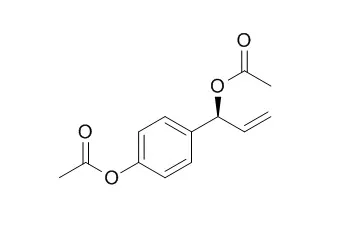| Kinase Assay: |
| Cancer research, 2005, 65(10):4417. | | 1'-acetoxychavicol acetate is a novel nuclear factor kappaB inhibitor with significant activity against multiple myeloma in vitro and in vivo.[Reference: WebLink] | 1'-Acetoxychavicol acetate (ACA) is a component of a traditional Asian condiment obtained from the rhizomes of the commonly used ethno-medicinal plant Languas galanga.
METHODS AND RESULTS:
Here, we show for the first time that ACA dramatically inhibits the cellular growth of human myeloma cells via the inhibition of nuclear factor kappaB (NF-kappaB) activity. In myeloma cells, cultivation with ACA induced G0-G1 phase cell cycle arrest, followed by apoptosis. Treatment with ACA induced caspase 3, 9, and 8 activities, suggesting that ACA-induced apoptosis in myeloma cells mediates both mitochondrial- and Fas-dependent pathways. Furthermore, we showed that ACA significantly inhibits the serine phosphorylation and degradation of IkappaBalpha. ACA rapidly decreased the nuclear expression of NF-kappaB, but increased the accumulation of cytosol NF-kappaB in RPMI8226 cells, indicating that ACA inhibits the translocation of NF-kappaB from the cytosol to the nucleus. To evaluate the effects of ACA in vivo, RPMI8226-transplanted NOD/SCID mice were treated with ACA. Tumor weight significantly decreased in the ACA-treated mice compared with the control mice.
CONCLUSIONS:
In conclusion, ACA has an inhibitory effect on NF-kappaB, and induces the apoptosis of myeloma cells in vitro and in vivo. ACA, therefore, provides a new biologically based therapy for the treatment of multiple myeloma patients as a novel NF-kappaB inhibitor. | | Carcinogenesis,1998,19(6):1007–1012. | | Inhibition by 1'-acetoxychavicol acetate of lipopolysaccharide- and interferon-gamma-induced nitric oxide production through suppression of inducible nitric oxide synthase gene expression in RAW264 cells.[Reference: WebLink] | Although nitric oxide (NO) is an important biological mediator, excessive production in inflammation is thought to be a causative factor of cellular injury and cancer in the long term.
METHODS AND RESULTS:
In the present study the effects of 1'-Acetoxychavicol acetate (ACA), which has anticarcinogenic properties, on NO production in murine macrophage cell line RAW264 cells stimulated with lipopolysaccharide or interferon-gamma were examined. ACA suppressed NO production dose dependently with an IC50 of 160 ng/ml (680 nM). The decrease in NO production was shown to parallel reduced expression of iNOS mRNA and protein. The influence of ACA on transcription factors, such as NF-kappaB, AP-1 and Stat1, which are involved in expression of the iNOS gene was assessed. ACA was found to suppress degradation of IkappaB, an NF-kappaB inhibitory factor, and consequently inhibit NF-kappaB activation. Activation of AP-1 and Stat1 was also blocked by ACA treatment.
CONCLUSIONS:
Thus we demonstrate that ACA exerts potent inhibitory effects on NO production, apparently mediated by modulation of activation of several transcription factors. This could contribute to the anticarcinogenic properties of ACA. |
|
| Animal Research: |
| Carcinogenesis,1997,18(5):1113-8. | | A xanthine oxidase inhibitor 1'-acetoxychavicol acetate inhibits azoxymethane-induced colonic aberrant crypt foci in rats.[Reference: WebLink] | The modifying effect of dietary administration of a xanthine oxidase inhibitor 1'-Acetoxychavicol acetate (ACA) present in an edible plant Languas galanga in Thailand on the development of azoxymethane (AOM)-induced colonic aberrant crypt foci (ACF) was investigated in rats.
METHODS AND RESULTS:
Male F344 rats were given s.c. injections of AOM (15 mg/kg body wt) once a week for 3 weeks to induce colonic ACF. They were fed the diets containing 100 or 200 ppm ACA for 5 weeks, starting 1 week before the first dosing of AOM. At the termination of the study (week 5), AOM induced 118 +/- 28 ACF/colon. Dietary administration of ACA caused significant reduction in the frequency of ACF (41% inhibition by 100 ppm ACA feeding and 37% inhibition by 200 ppm ACA feeding, P<0.01). Such inhibition might be associated with suppression of the proliferation biomarkers' expression such as ornithine decarboxylase activity in the colonic mucosa, number of silver-stained nucleolar organizer regions' protein in the colonic mucosal cell nuclei and blood polyamine content.
CONCLUSIONS:
These results indicate that ACA could inhibit the development of AOM-induced ACF through its suppression of cell proliferation in the colonic mucosa and ACA might be a possible chemopreventive agent against colon tumourigenesis. |
|






 Cell. 2018 Jan 11;172(1-2):249-261.e12. doi: 10.1016/j.cell.2017.12.019.IF=36.216(2019)
Cell. 2018 Jan 11;172(1-2):249-261.e12. doi: 10.1016/j.cell.2017.12.019.IF=36.216(2019) Cell Metab. 2020 Mar 3;31(3):534-548.e5. doi: 10.1016/j.cmet.2020.01.002.IF=22.415(2019)
Cell Metab. 2020 Mar 3;31(3):534-548.e5. doi: 10.1016/j.cmet.2020.01.002.IF=22.415(2019) Mol Cell. 2017 Nov 16;68(4):673-685.e6. doi: 10.1016/j.molcel.2017.10.022.IF=14.548(2019)
Mol Cell. 2017 Nov 16;68(4):673-685.e6. doi: 10.1016/j.molcel.2017.10.022.IF=14.548(2019)